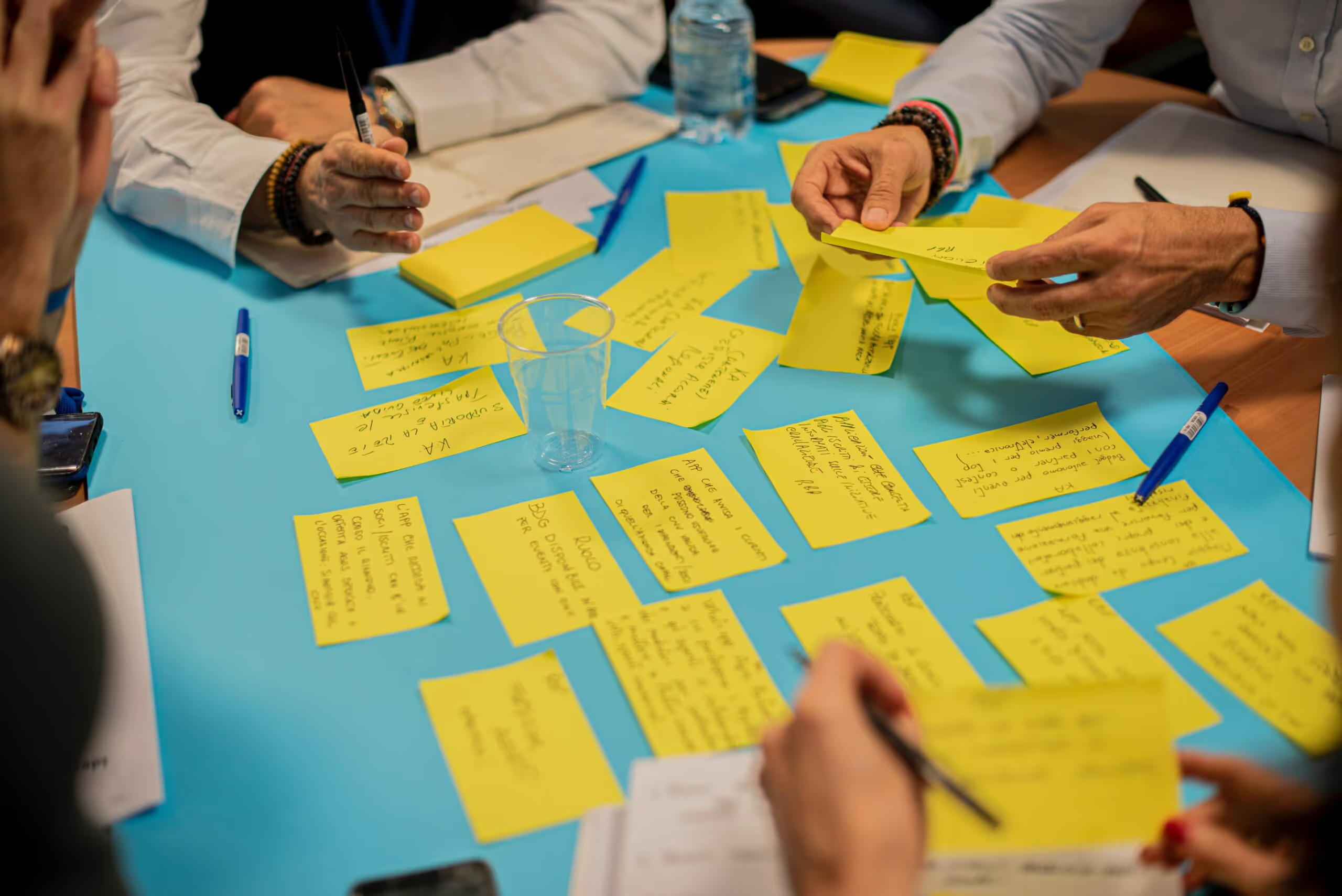Accelerating speed and quality of decision-making

Related content

Client need
An international bank was facing serious competition from Fin Tech firms, fast-changing customer needs, digital innovation requirements, and an old, slow, constraining structure. To stay relevant they needed to quickly shift to Agile and stand up streams that would drive change at pace. This required structural, procedural, and organisational change, as well as mindset shifts for leaders and teams.
To achieve this goal, the organisation partnered with BTS to devise a coaching solution that targeted mindset shifts at a deep level, creating a disruptive moment for leaders to accelerate the rate of change.
“Our engagement survey increased by six points. Our target was 77, and we exceeded that with a score of 79. This is a significant improvement. We have a highly engaged team and I have no doubt that this experience contributed substantially to the result. There is now more transparency in speaking up when things aren’t going right; we have really seen this happening in the last month. I attribute this change to the program we did with BTS.”
- Leader of bank
Solution
The company set a target to shift mindsets so that:
- Employees saw customer and enterprise success as the goal, not just personal and individual gain.
- Healthy risk was considered natural, and failure was an opportunity to learn and grow– a better option than playing it safe.
- Resources were seen as shared and owned by the enterprise, instead of seeking personal control as the only way to succeed.
- Embracing conflict and tension were considered constructive and creative challenges that led to better customer outcomes.
There were several experiences that helped to disrupt and shift the mindsets, which included:
- A digital, virtual, moments-based simulation experience, which helped employees explore specific moments when they would be challenged to implement new agile behaviors. This approach was team-based and surfaced the true moments of tension so that they could be addressed and planned for.
- Virtual, personalised 1:1 coaching to create deep mindset changes on topics such as engaging others, building commitment and support, influencing, personal authority, speaking up, and challenging the status quo.
Results
The experience leveraged a control group to measure the mindset changes for those receiving the 1:1 coaching. Across the six critical mindsets the firm sought to address, there was an average 17.3% gain in the coached group in comparison to the control group.
Coaching groups’ confidence in their ability to lead and influence others increased by 11%.
In the simulation experience the average score was 9.03/10, and 24 respondents reported an NPS of 75.

Client need
A leading global social networking organization was implementing a new process for product development. To bring this structural change to fruition, the organization’s leaders needed to help their teams work together more cohesively. Thus, the organization partnered with BTS to help their people better understand their own roles, their teammates’ roles, and their collective goals, all to spur along the new product development process.
Solution
To achieve this goal, the company and BTS created a virtually delivered learning program that reached 260 people divided into 17 cohorts. Each cohort was comprised of both individual contributors and experienced managers across different functions. The program, completed over the course of three months, consisted of:
- Two half-day workshops
- Go-Dos, which are actionable steps to take back on the job
- Playbooks, a tool that demonstrates how each role can live the company’s values during their day-to-day work
- Experience maps, or self-development tools that 1) identify realistic, role-specific situations and 2) list actionable steps for building key capabilities
- Momenta: BTS’s proprietary digital platform that allows people to explore someone else’s role by accessing their playbooks and experiencing their daily dilemmas, ultimately building cross-functional empathy
The learning program was designed to meet people where they were and was fully customized to the organization’s unique values and culture.
Results
Participating managers have improved their abilities to ideate and follow through, align teams through difficult conversations, create attainable road maps, apply organizational frameworks, and measure success. As of now, 76% of the 259 participants have completed the initial phases of the learning journey, and have mentioned learning the following:
- “Don't be afraid to speak up, ask for help on understanding wants, needs and blockers, attend more meetings with [cross-functional teams], be bold, make assertions, [or] ask the hard-hitting questions."
- “I need to do a better job of avoiding heroic efforts personally to fix the problem. I need to also avoid micromanaging the team as they work through a course correction.”- Technical Manager
- “I would like to work on delegation through making better connections, [including] painting a clear picture of how my work will appeal to all stakeholders by gaining a better understanding of what is important to them.”

Client need
Facing serious competition from Fin Tech firms, fast-changing customer needs, digital innovation requirements, and an old, slow, constraining structure, an international bank needed to quickly shift to Agile and stand up streams that would drive change at pace. This required structural, procedural, and organizational change, as well as mindset shifts for leaders and teams.
To achieve this goal, the organization partnered with BTS to devise a coaching solution that targeted mindset shifts at a deep level, creating a disruptive moment for leaders to accelerate the rate of change.
The solution…
The firm set a target to shift mindsets so that:
- Employees saw customer and enterprise success as the goal, not just personal and individual gain.
- Healthy risk was considered natural, and failure was an opportunity to learn and grow – a better option than playing it safe.
- Resources were seen as shared and owned by the enterprise, instead of seeking personal control as the only way to succeed.
- Embracing conflict and tension were considered constructive and creative challenges that led to better customer outcomes.
There were several experiences that helped to disrupt and shift the mindsets, which included:
- A digital, virtual, moments-based simulation experience, which helped employees explore specific moments when they would be challenged to implement new agile behaviors. This approach was team-based and surfaced the true moments of tension so that they could be addressed and planned for.
- Virtual, personalized 1:1 coaching to create deep mindset changes on topics such as engaging others, building commitment and support, influencing, personal authority, speaking up, and challenging the status quo.
Results
The experience leveraged a control group to measure the mindset changes for those receiving the 1:1 coaching. Across the six critical mindsets the firm sought to address, there was an average 17.3% gain in the coached group in comparison to the control group.
Coaching groups’ confidence in their ability to lead and influence others increased by 11%.In the simulation experience the average score was 9.03/10, and 24 respondents reported an NPS of 75.
Quote from the leader of this experience in the bank:
- “Our engagement survey increased by six points. Our target was 77, and we exceeded that with a score of 79. This is a significant improvement. We have a highly engaged team and I have no doubt that this [experience] contributed substantially to the result.”
- “There is now more transparency in speaking up when things aren’t going right; we have really seen this happening in the last month. I attribute this change to the program we did with BTS.”
Related content

Client need
Safety in the transportation industry has often been treated as a set of rules to follow and boxes to check. But one Spanish railway organization saw an opportunity to redefine safety as something far greater, a core value embedded into the culture of their company at every level.
This bold vision demanded more than compliance. It required a cultural transformation to challenge outdated behaviors, inspire teams, and empower leaders to embrace and model a safety-first mindset. For years, the organization had been working to foster a culture that prioritized protection over profit, setting new behavioral standards across the industry.
To accelerate this shift, the organization partnered with BTS to design a leadership development program that dismantled old practices and equipped leaders with the tools, insights, and behaviors needed to bring their vision to life.
- Deconstruct existing mindsets to enable cohesive change.
- Identify barriers preventing progress.
- Equip leaders with practical behavioral knowledge and tools.
Solution
BTS partnered with the organization to design a leadership journey that would reshape not just processes but perspectives, fostering a workplace where physical and psychological safety were paramount. Over eight months, the project team conducted interviews with leaders and focus groups to uncover critical behavioral insights and tailor the program to the organization’s unique needs.
Participants explored essential themes, including:
- Embedding safety into daily decision-making.
- Cultivating greater awareness of safety risks.
- Understanding the influence of their leadership on safety outcomes.
- Leading by example to set a cultural standard.
- Building trust, commitment, and open communication within their teams.
The program unfolded in three distinct phases to drive lasting behavioral change:
- Workshop preparation
Participants began with a self-assessment to uncover personal “safety blind spots” and mind traps. This phase, delivered through a custom online platform, helped leaders reflect on their current practices and prepare for the transformational journey ahead.
- Safety workshop
The one-day, immersive workshop was designed to spark deep conversations about safety culture, challenge ingrained mindsets, and equip participants with actionable strategies for change. Leaders engaged in real-world scenarios to explore the implications of their decisions and practice new behaviors. The day concluded with collaborative debrief sessions, leaving participants with practical tools to implement their insights immediately. - Implementation in action
To sustain momentum, the post-workshop phase extended over six months, offering six targeted activities. These activities reinforced key lessons, encouraged team collaboration, and provided ongoing support for integrating safety-first behaviors into daily routines.
The leadership program was delivered to 1500 participants over 66 workshops in seven locations across Spain.
Results
To measure results, the project team created a resource map evaluating progress.
Average completion rate of Activities One–Three: 57 percent. (One: 78.21%; Two: 53. 01%; Three: 40.57%)
A post-workshop survey was sent to participants, reporting on the following metrics:
- Average satisfaction — 4.7/5.
- Trainer’s evaluation — 4.9/5.
- NPS — 82 percent.
- “Saw improvement in safety alignment” — 93 percent.
- “Integrated safety tools in daily roles” — 82 percent.
- “Identified new initiatives for improving safety” — 77 percent.
- “Mitigated team/peer mind traps” — 93 percent.
- “More aware of risk in daily roles” — 98 percent.
- “Identified a normalized risk to work on” — 92 percent.
Testimonials
- “Many of the methodologies and tools not only help to improve safety but can also be used to improve operational or organizational processes.”
- “It has put us in front of the mirror of how we are today in terms of safety culture, opening our eyes to our development areas. Very participative and practical.”

Over the years, BTS has expanded its global footprint through thoughtful acquisitions and collaborations, bringing new creative capabilities and local expertise into the fold. From digital design studios to leadership consultancies across Europe, Asia, and the Americas, we’ve built a community that blends shared values with local perspective. That diversity has become one of our greatest strengths, shaping how we design and deliver learning that feels deeply personal everywhere we work.
Whether someone is in a leadership journey in Singapore, a coaching program in São Paulo, or a strategy workshop in Stockholm, the goal is always the same: to make the experience feel like it was made just for them.
Many of those experiences live on Momenta, BTS’s digital experience platform, powering journeys like Coaching, Multipliers, and other core programs.
As those experiences grew, so did the need for nuance. Every journey had to feel local, not just sound translated. Tone, humor, and cultural context have always been central to the BTS approach, and as demand expanded across formats and regions, our translation model was ready for its next evolution.
In early 2024, the team began exploring how AI could help. Rather than treating technology as the destination, we saw it as a catalyst, a way to rethink translation and deliver richer, more customized client experiences at scale. That curiosity sparked one of BTS’s most ambitious AI-first experiments, led by our Global Product Enablement Function team in partnership with our global network of linguists and translators.
Shifting to AI-first
The next step was finding the right place to experiment. Enter Phrase, a cloud-based translation management platform that quickly became our test lab. Phrase brings every part of the translation process into one place, from machine translation engines to human review, terminology management, and workflow tracking. It gives our linguists, designers, and project teams a shared space to collaborate, test ideas, and learn.
Over the next few months, two key discoveries reshaped how we think about translation, and ultimately, how we work.
Key discovery 1: Making AI a teammate
We began with a clear goal: make translation faster and more consistent. Using Phrase, AI handled the first drafts while our linguists refined them. Quickly, we realized there was potential for AI-value that went far beyond speed.
With AI completing the first 80% of the work in a fraction of the time, our linguists could focus on what matters most: nuance, tone, and cultural resonance. The relationship evolved from oversight to collaboration, AI structured and scaled, humans shaped and elevated.
The result was more than efficiency. It was better work, created by people and technology learning to amplify each other.
Key discovery 2: Turning a roadblock into a redesign
Next came a design challenge. Phrase, like most translation tools, struggled with text embedded in graphics, a hallmark of many BTS learning experiences. Instead of forcing the tool to adapt, we changed how we created.
We began designing with translation in mind: simplifying visuals, reducing text, and using modular components that could flex across languages. The constraint sparked better design, easier to scale, more consistent, and more inclusive for every audience.
Key discovery 3: Integrating systems for scale
With people, AI, and design in sync, the last barrier was process. Managing translations between Phrase and Momenta still required manual effort.
To fix that, we built an API integration linking the two platforms. Now, files move automatically, progress is tracked in real time, and everything stays connected.
That integration turned our workflow into a unified ecosystem, fast, transparent, and ready to scale globally.
Business impact
Just 18 months ago, our translation reviews lived in double-column Word docs. Today, we work in a fully connected, AI-first ecosystem. Each project feeds the next, refining prompts, tone profiles, and design patterns, so our translation process keeps getting faster, smarter, and more aligned with BTS’s voice.
Speed and quality. Translation cycles that once took months now wrap up in weeks, cutting turnaround times by over 40%. Phrase’s tools and AI-powered workflows accelerate production while maintaining quality through expert-approved reuse, glossaries, and automated quality checks. Even complex formats like videos and animations are localized faster, with AI supporting linguists at every step.
Smarter workflows. The integration between Momenta and Phrase automates project transfers and tracking, saving an estimated 2.5 hours per project. Teams across language, digital, and project management now collaborate in one streamlined environment.
Human focus. Our linguists remain the engine of quality and innovation. With AI managing repetitive tasks, they focus on nuance and meaning, and go further by creating specialized GPTs, training databases, and testing translation engines to continually raise the bar.

When BTS invented business simulations in the 1980s, leadership development was mostly theoretical – case studies, lectures, and frameworks about what good decisions looked like. Simulations changed that. They let leaders learn by doing, stepping into a realistic version of their business to test strategy, make decisions, and see the impact before the stakes were real.
Since then, simulations have evolved from spreadsheets to digital platforms to immersive virtual experiences that capture the complexity of leading in today’s world. Now, large language models and agentic AI are opening a new frontier, one where simulations evolve as fast as the world they reflect and experiential learning scales with the pace of change.
Creating space for exploration
Test quickly, abandon what doesn’t work, and share what you learn.
– Jessica Skon, CEO, BTS
A handful of simulation experts were pulled out of their day-to-day work and given the freedom to set their own direction. They had the authority to shape the roadmap and the protection to explore bold ideas without fear of critique. The brief was simple: go figure out what’s possible.
They had cover to fail fast, freedom to explore, and permission to get a little messy. Early wins were interesting but small. AI could draft faster, automate a few things – helpful, sure. Transformative? Not yet.
The breakthrough came when we stopped trying to bolt AI on to what we already did. We rebuilt our simulation platforms, our processes, and tools from the ground up around AI. Suddenly it wasn’t just about micro-gains & efficiencies, the canvas of possibility was much larger.
From experimentation to acceleration
So, we tested. Some tools showed promise, others, not so much. Every experiment taught us something. Each “failure” made us sharper about where AI could actually help, and where it would just get in the way.
What began as small experiments turned into a new way of working, a process and platform working as one.
AI now accelerates the first 80% of the work, the structure, synthesis, and early drafts, freeing BTS consultants to focus on the high-impact moments that drive behavior change: dilemmas, trade-offs, and conversations that build conviction.
Our new AI simulation platform and AI-First development process operationalizes that process:
- Enabling live co-creation and branching edits with clients
- Applying light guardrails for quality and security
- Integrating with enterprise systems for compliance and control
AI accelerates, people transform. That combination is what makes BTS… BTS.
Clients feel the impact in four ways
- Fast spin-ups for focused needs
For targeted challenges like coaching a customer conversation, debriefing a safety incident, aligning a sales team, we can now stand up bespoke simulations in days, not weeks. Teams co-create live; scenarios adjust in the room; relevance is immediate. - Enterprise simulations for strategy alignment
For multi-round, high-fidelity simulations, AI accelerates the structure without compromising quality. BTS experts still craft the dilemmas and trade-offs that drive conviction. - A broader platform portfolio
Beyond enterprise simulations, we now support conversational practice, skill drills, workflow redesign, and company or market modeling, helping clients choose the right tool for each need. - On-demand, without the risk
Clients can use our AI platform for self-authored micro-sims, where speed and iteration matter most. Our toolchain scaffolds the flow, enforces guardrails, and keeps quality high.
The best model is flexible: enable where DIY shines, co-build for complex challenges, and experts lead end-to-end when outcomes matter most.
What clients are already seeing
- Weeks to hours: Work that once took six weeks was delivered as a high-fidelity experience in just 13 hours, specific enough to engage a CEO on first pass.
- Lean, agile teams: Projects that required seven consultants now take two, with no loss in quality or impact.
- Live collaboration: Simulations are built with clients, not for them, adjusted in real time during design and delivery.
The result: faster delivery, deeper relevance, and experiences that scale across an enterprise without losing the human touch.
The bigger picture
BTS simulations have always given leaders a safe place to wrestle with real dilemmas. AI hasn’t changed that, it’s expanded the canvas. By rebuilding how we design and deliver simulations, we’ve removed the trade-off between speed and substance.
Focused needs can now be met in days. Complex transformations can move at the pace of business. Clients can engage however they choose, DIY, co-create, or end-to-end, with BTS expertise guiding every step.
We’re still early in this chapter, just like our clients. But the direction is clear: faster, smarter, more scalable experiential learning, anchored in human judgment, strategic alignment, and the craft that defines BTS.

